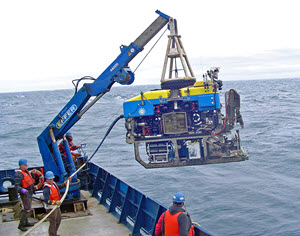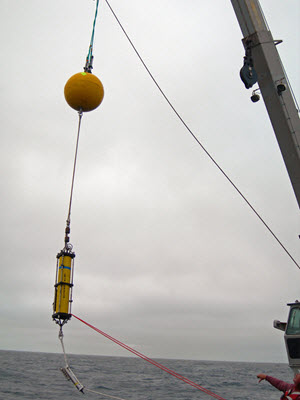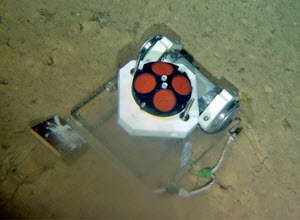
The remotely operated vehicle (ROV) Jason II being deployed from R/V Atlantis. The researchers use the ROV to position the acoustic scintillation moorings in specific locations to capture vertical upwelling flows. (Photo by Daniela Di Iorio)
There is a lot of action at the bottom of the Gulf of Mexico. A turbulent mixed layer of water and sediment particles known as the bottom boundary layer circulates counterclockwise across the seafloor, flowing against the water above.
Meanwhile, oil and gas naturally seep into this active environment from the seafloor. Scientists are investigating how the dynamics of this bottom layer affect the vertical movement of seeping hydrocarbons and the resuspension of previously deposited hydrocarbons to better predict where oil spilled in the deep Gulf will go.
The Gulf of Mexico Research Initiative recently awarded Dr. Daniela Di Iorio a grant to measure the long-term vertical upwelling processes of hydrocarbon plumes and determine the impacts of bottom boundary layer dynamics on hydrocarbon distribution and resuspension.
A lack of long-term measurements of these natural processes has limited our understanding of their impact on oil released from natural seeps and oil rigs such as the Deepwater Horizon.

The bosun of the R/V Atlantis (bottom right) indicates that the acoustic scintillation receiver mooring is clear to be lowered into the water. Di Iorio’s team will use this instrumentation to monitor the hydrocarbon plume. (Photo by Daniela Di Iorio)
Di Iorio’s team will observe an oil and gas plume from a natural seafloor seep for three months using acoustic scintillation, focusing on the point where seep materials reach the top of the bottom boundary layer. The acoustic scintillation method observes how sound waves fluctuate as they pass through the plume to determine the amount of vertical upwelling and turbulence. Di Iorio noted, “This work is an extension of our previous work with hydrothermal plumes. To date, there is nobody that monitors long-term vertical velocities of deep sea hydrocarbon plumes, and the three-month time period is critical for assessing seeps’ temporal variability.”
While some hydrocarbon escapes the boundary layer and rises to the surface, residual materials remaining in the bottom layer may encounter energetic processes near the seafloor. The team will use an Acoustic Doppler Current Profiler and hydrographic sensors to measure bottom boundary layer processes that may affect hydrocarbon dispersal.
The data will allow researchers to measure turbulent fluxes and mixing levels in the bottom boundary layer and identify strong flows near the seabed that could cause sedimented oil resuspension and mixing between the boundary layer and the overlying water column.

The researchers use a bottom-mounted Acoustic Doppler Current Profiler to monitor turbulent bottom boundary layer flows. (Photo by Daniela Di Iorio)
Di Iorio stated, “The measurements we hope to collect will provide a useful complement to on-going studies funded through GoMRI consortia, particularly research by the ECOGIG team on natural seep research and the CARTHE and DROPPS teams on oil transport.”
The project’s researchers are Daniela Di Iorio of the University of Georgia and Andreas M. Thurnherr of Columbia University. Their project is Vertical Upwelling and Bottom-Boundary Layer Dispersal at a Natural Seep Site.
************
This research was made possible in part by a grant from the Gulf of Mexico Research Initiative (GoMRI) to the University of Georgia Department of Marine Sciences and Columbia University’s Lamont-Doherty Earth Observatory for their project Vertical upwelling and bottom-boundary layer dispersal at a natural seep site.
The Gulf of Mexico Research Initiative (GoMRI) is a 10-year independent research program established to study the effect, and the potential associated impact, of hydrocarbon releases on the environment and public health, as well as to develop improved spill mitigation, oil detection, characterization and remediation technologies. An independent and academic 20-member Research Board makes the funding and research direction decisions to ensure the intellectual quality, effectiveness and academic independence of the GoMRI research. All research data, findings and publications will be made publicly available. The program was established through a $500 million financial commitment from BP. For more information, visit http://gulfresearchinitiative.org/.
